Actinidia chinensis: a tropical plant in your garden
Actinidia Chinese is a liana, the fruits of which are more familiar to Russians under the name of kiwi. It grows wild in Western and Northern China, where its fruits are used not only for cooking, but also for medicinal purposes. Kiwi has long become a common fruit for our compatriots, but not everyone knows that it can be grown in your own garden. Long-term selection work made it possible to develop varieties that may well exist in Russian conditions and bear fruit successfully. Russian amateurs have the opportunity to decorate the garden with interesting and useful exotic things.
Content
- General characteristics of Chinese actinidia
- Growing conditions for Chinese Actinidia
- Planting and starting growing
- Chinese Actinidia Care
- Harvesting and using fruits
General characteristics of Chinese actinidia
Features of Chinese Actinidia:
- Actinidia chinensis is climbing vine, the height of which can reach 8 meters.
- It has curly shoots that are supplied with reddish hairs.
- The pubescent reddish leaves are large.
- Actinidia belongs to dioecious plants, that is, on one liana there will be only male flowers, on the other - only female flowers. This creates the need for cross-pollination, so you always need to grow several vines.
- For a start, it is enough to plant two plants.
Female flowers on a liana are located singly, they can be easily distinguished by their large stamens and a large pistil. Male flowers are collected in inflorescences, on which up to 17 buds can be located. They contain many small stamens with yellow anthers.
Actinidia Chinese begins to bloom in early May: the vine looks very beautiful when white buds appear on it.
In the future, they will become creamy, they smell a little like roses. Actinidia has hemispherical fruits with a pubescent dark green skin. It is interesting that the fruits on the liana do not ripen until the end, they must be harvested at the very end of autumn, but it is necessary to be in time before the first frost.
Kiwi has a really great taste, it contains a huge amount of vitamins and other useful substances. Ripe berries are used for fresh food, they can be used to make jam and other dishes.
Growing conditions for Chinese Actinidia
Actinidia is found in the wild in the Primorsky Territory, it also grows on Sakhalin. However, several large-fruited varieties have now been obtained that are suitable for most Russian regions. This plant does not belong to winter hardy, so for the winter it needs to be covered like grapes.
With proper agricultural technology, it is quite possible to achieve a good harvest by protecting the kiwi from frost and excessive heat.
You can grow Chinese actinidia from seeds, but it is much easier to use seedlings. It is a climbing liana that usually grows on props and can also be used as a decoration for hedges.
Basic conditions for good growth:
- Chinese actindia needs choose the right place... A structure is pre-installed, which will further entwine the vine. This can be a gazebo, hedge, pergola, simple supports, etc.It is important that a lot of light falls on the plant, low illumination significantly affects the yield.
- Caring for actinidia necessarily includes digging up the earth at the planting site, and this must be done very carefully so as not to damage the root system of the vines. When digging, the soil is mulched, in addition, fertilizers must be applied to it: in the spring it is ammonium nitrate and phosphorus additives, in the fall - humus and superphosphates.
- It is necessary to periodically prune the vine, removing all diseased or damaged shoots.
- Regular watering. Liana needs a lot of water, the soil near the roots must be constantly moist. It is not recommended to plant it near the walls of capital buildings so as not to erode the foundation, but it can be an excellent decoration, for example, for a summer shower.
The best soil option for Chinese actinidia is sod land, humus and sand in a ratio of 2: 2: 1.
If you have to grow this vine on heavy clay soils, it is necessary to provide a mandatory drainage layer before planting. Usually it is made from broken brick or expanded clay, which will help remove excess moisture from the roots.
Planting and starting growing
Actinidia seedlings have long become commonplace for certain areas; in the middle lane they still have to be ordered from afar.
This is the most simple breeding option, which will allow you to get the first fruits faster and does not require any special agrotechnical knowledge. When planting seeds, the first harvest can be obtained only after 6-8 years, planting seedlings can significantly speed up the process (fruiting age - 4-5 years). At the same time, the liana does not give fruit every year, usually about one season out of three is fruitful.
Planting Tips:
- Planting is carried out in the spring, for them you need to prepare pits 40 cm deep, 60-70 cm wide.
- If several plants are supposed to be planted in one row, the distance between them should be at least 1.5-2.5 m.
- Nutrient soil is laid in the pit on the drainage layer, humus, sand and sod land with the addition of superphosphate.
- Wood ash can be added to the potting mix.
- It is recommended to pre-moisten the roots of seedlings with water, they are placed in the ground to a depth of 2-3 cm below the root neck.
- After planting, the seedlings need to be watered: each plant should get 2-3 buckets of water.
- The soil needs to be mulched: peat or small rotted sawdust is introduced into it.
It is important to ensure that male and female plants are planted: for 15 female vines, one male is enough. It is necessary to take care of the supports: plants can wrap around an arch or other structure, and if it is not there, you need to install supports immediately after planting.
The normal height of the supports is 2-2.5 meters, it is recommended to use metal posts with a wire mesh stretched between them.
Wooden supports should not be used: over time, due to high humidity, they will simply rot and the plants will fall to the ground. Ground cover growing is possible, but actinidia will bear fruit worse.
Chinese Actinidia Care
Actinidia grows fast enough, and soon it forms a magnificent green carpet on the supports. Most species and varieties have high decorative qualities, it looks especially impressive on large areas. Lianas always look exotichowever, if the right conditions are maintained, they are able to bear fruit for many years.
What you need to know to get the maximum yield from each plant:
- Throughout the life of the plant, you need to periodically prune. In the first 10 years of lianas life, it is enough to remove dried and damaged branches, in the future, regular removal of old shoots will help maintain good fruiting.
- At the same time, pruning cannot be carried out in the spring, since active sap flow begins at this time. Shoots are cut at the beginning of autumn so that the creeper has time to heal wounds before the cold weather.Pruning will allow you to form a fan-shaped, even crown that can take up the maximum usable space.
- In the autumn period, the root system must be protected: it is covered with fallen leaves, sawdust, and other mulch options. In cold periods, they will not allow the roots to freeze, and in the spring, due to decay, they will turn into a useful fertilizer.
- Liana does not like drafts, so it is better to place it away from heavily blown places. An interesting solution: it can be used to create a temporary structure or an outdoor shower. The dense sheet carpet will become a real green wall, impenetrable from the outside view.
In nature, forest vines usually develop in the shade of their support, and subsequently they take out shoots in the open sun. Shading young plants slightly will help them grow faster and yield faster. In this case, an adult plant needs the sun. Actinidia Chinese is the best option for creating a green fence for a playground on a site or recreation area.
The tropical plant helps create a special ambiance that the greenery lover will surely enjoy.
Important! Actinidia shoots have a special ethereal smell that cats like very much. To prevent mustachioed fluffy pests from destroying the seedlings, the plantings must be covered with a net.
Harvesting and using fruits
The hairy fruits begin to ripen in early August, there are early and late ripening varieties. Most often, actinidia finally ripens only in late autumn, when the fruits have already been harvested and stored.
- One of the most common varieties is Actinidia Emerald, this plant allows you to get up to 12 kg of fruit from one vine. They have a pleasant sweet and sour taste and keep well.
- Another popular variety is Actinidia Purple Garden. Interestingly, there are no hairs on the fruits, their skin is completely smooth. From one bush, you can get up to 28 kg, this particular variety is the richest in vitamin C and other substances useful for health.
- The fruits of Actinidia Figurnaya have the best taste, although this variety does not have the highest yield: a maximum of 15 kg of kiwi can be obtained from a bush.
The fruits of actinidia (kiwi) are a real storehouse of useful substances, they are very useful in the treatment of vitamin deficiencies and other diseases.
They are low-calorie, so they are very useful for losing weight, they contain various sugars, trace elements and other useful substances. It is not so difficult to grow this vine, and it can become one of attractions in your garden.
More information can be found in the video.



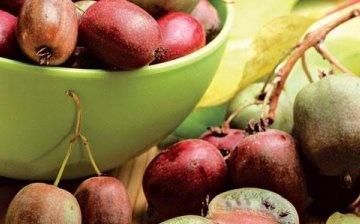
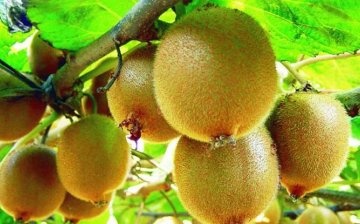
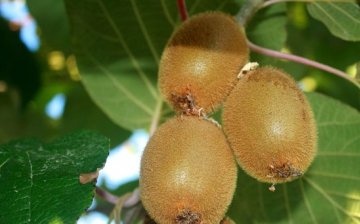
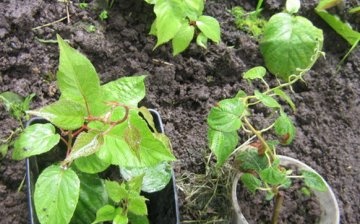
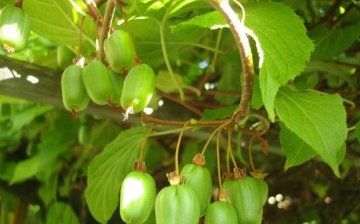
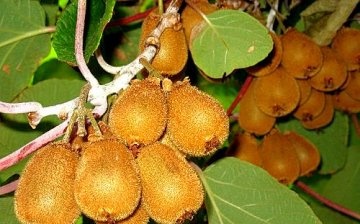






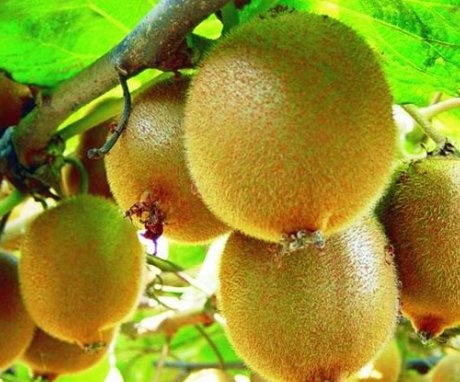
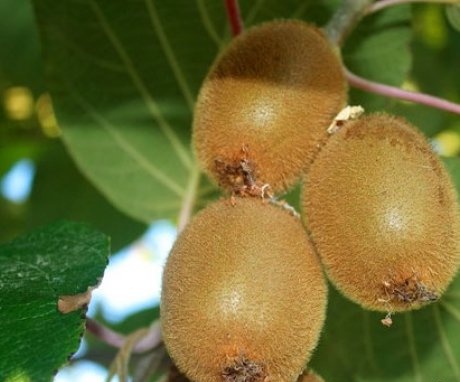
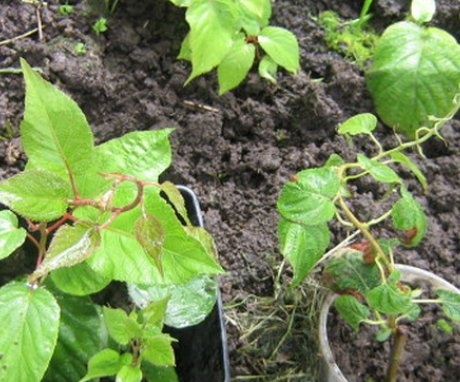

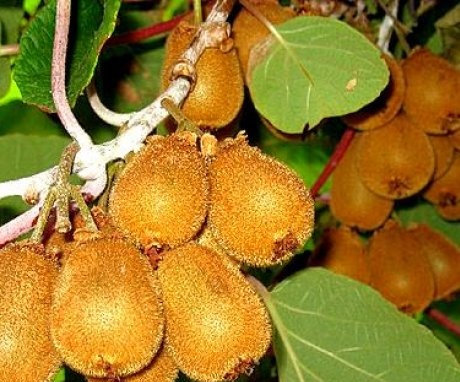
For a long time it was not possible to grow this plant in my garden, it did not work out in any way. I think I didn’t fertilize much.